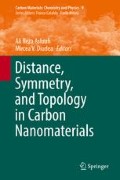Abstract
Molecular dynamics calculations can reveal the physical and chemical properties of various carbon nanostructures or can help to devise the possible formation pathways. In our days the most well-known carbon nanostructures are the fullerenes, the nanotubes, and the graphene. The fullerenes and nanotubes can be thought of as being formed from graphene sheets, i.e., single layers of carbon atoms arranged in a honeycomb lattice. Usually the nature does not follow the mathematical constructions. Although the first time the C60 and the C70 were produced by laser-irradiated graphite, the fullerene formation theories are based on various fragments of carbon chains and networks of pentagonal and hexagonal rings. In the present article, using initial structures cut out from graphene will be presented in various formation pathways for the armchair (5,5) and zigzag (9,0) nanotubes. The interatomic forces in our molecular dynamics simulations will be calculated using tight-binding Hamiltonian.
Access this chapter
Tax calculation will be finalised at checkout
Purchases are for personal use only
References
Allen MP, Tildesley DJ (1996) PC computer simulation of liquids. Clarendon Press, Oxford
Baggott J (1996) Perfect symmetry. The accidental discovery of buckminsterfullerene. Oxford University Press, Oxford/New York/Tokyo
Bethune DS, Kiang CH, De Vries MS, Gorman G, Savoy R, Vazquez J, Beyers R (1993) Cobalt catalysed growth of carbon nanotubes with single-atomic-layer walls. Nature 363:605–607
Bochvar DA, Galpern EG (1973) Hypothetical systems: carbododecahedron, s-icosahedron and carbo-s-icosahedron. Dokl Acad Nauk SSSR 209:610–612 (In Russian)
Boehm HP (1997) The first observation of carbon nanotubes. Carbon 35:581–584
Boorum MM, Vasil’ev YV, Drewello T, Scott LT (2001) Groundwork for rational synthesis of C60: cyclodehydrogenation of a C60H30 polyarene. Science 294:828–831
Chen Z, Lin Y, Rooks MJ, Avouris P (2007) Graphene nanoribbon electronics. Phys E 40:228–232
Chuvilin A, Kaiser U, Bichoutsskaia E, Besley NA, Khlobystov AN (2010) Direct transformation of graphene to fullerene. Nat Chem 2:450–453
Dresselhaus MS, Dresselhaus G, Eklund PC (1996) Science of fullerenes and carbon nanotubes: their properties and applications. Academic Press, New York/London
Fowler PW, Manolopulos DE (1995) An atlas of fullerenes. Clarendon Press, Oxford
Frenkel S, Smit B (1996) Understanding molecular simulation. Academic Press, San Diego
Geim AK, Novoselov KS (2007) The rise of graphene. Nature Mat 6:183–191
Han MY, Ozylmaz B, Zhang YB, Kim P (2007) Energy band-gap engineering of band gap nanoribbons. Phys Rev Lett 98:206805
Hoover WG (1985) Canonical dynamics: equilibrium phase-space distributions. Phys Rev A31:1965–1967
Iijima S (1991) Helical microtubules of graphite carbon. Nature 354:56–58
Iijima S, Ichihashi T (1993) Single-shell carbon nanotubes of 1nm diameter. Nature 363:603–605
Jones DEH (1966) Ariadne. New Scientist 32: 245–245.
Krätschmer W (2011) The story of making fullerenes. Nanoscale 3:2485–2489
Krätschmer W, Lamb LD, Fostiropoulos K, Huffman DR (1990) Solid C60. A new form of carbon. Nature 347:354–358
Kroto HW (1992) C-60-Buckminsterfullerene, the celestial sphere that fell to earth. Angew Chem Int Ed 31:111–129
Kroto HK, Heath JR, O’Brien SC, Curl RF, Smalley RE (1985) C60: buckminsterfullerene. Nature 318:162–163
Landau LD (1937) Zur Theorie der Phasenumwandlungen II. Phys Z Sowjetunion 11:26–35
Larsson S, Volosov A, Rosen A (1987) Optical spectrum of the icosahedral C60 – “follene-60”. Chem Phys Lett 137:501–504
László I (1998) Formation of cage-like C60 clusters in molecular-dynamics simulations. Europhys Lett 44:741–746
László I, Udvardi L (1987) On the geometrical structure and UV spectrum of the truncated icosahedron molecule. Chem Phys Lett 136:418–422
László I, Zsoldos I (2012a) Graphene-based molecular dynamics nanolithography of fullerenes, nanotubes and other carbon structures. Europhys Lett 99:63001p1–63001p5
László I, Zsoldos I (2012b) Molecular dynamics simulation of carbon nanostructures: the C60 buckminsterfullerene. Phys Stat Solidi B 249:2616–2619
László I, Zsoldos I (2014) Molecular dynamics simulation of carbon nanostructures: the D5h C70 fullerene. Phys E 56:422–426
Monthioux M, Kuznetsov VL (2006) Who should be given the credit for the discovery of carbon nanotubes? Carbon 44:1621–1623
Nosé S (1984) Molecular dynamics method for simulations in the canonical ensemble. Mol Phys 52:255–268
Novoselov KS, Geim AK, Morozov SV, jiang D, Zhang Y, Dubonos SV, Grigorieva IV, Firsov AA (2004) Electric field effect in atomically thin carbon films. Science 306:666–669
O’Rourke J (2011) How to fold it science of fullerenes and carbon nanotubes: their properties and applications. Cambridge University Press, Cambridge
Osawa E (1970) Superaromaticity. Kagaku 25:854–863 (In Japanese)
Peierls RE (1935) Quelques propriétés typiques des corps solides. Ann I H Poincaré 5:177–222
Porezag D, Frauenheim T, Köhler T, Seifert G, Kaschner R (1995) Construction of tight-binding potentials on the basis of density-functional theory – Application to carbon. Phys Rev B 51:12947–12957
Radushkevich LV, Lukyanovich VM (1952) About the structure of carbon formed by thermal decomposition of carbon monoxide on iron substrate. Zurn Fisic Chim 26:88–95 (in Russian)
Schultz HP (1965) Topological organic chemistry. Polyhedranes and prismanes. J Org Chem 30:1361–1364
Scott LT, Boorum MM, McMahon BJ, Hagen S, Mack J, Blank J, Wegner H, Meijere A (2002) A rational chemical synthesis of C60. Science 295:1500–1503
Semenoff GW (1984) Condensed-matter simulation of a three-dimensional anomaly. Phys Rev Lett 53:2449–2452
Tapasztó L, Dobrik G, Lambin P, Bíró L (2008) Tailoring the atomic structure of graphene nanoribbons by scanning tunneling microscope lithography. Nat Nanotechnol 3:397–401
Terrones M, Banhart F, Grobert N, Charlier J-C, Terrones H, Ajayan PM (2002) Molecular junctions by joining single-walled carbon nanotubes. Phys Rev Lett 89:075505
Verlet L (1967) Computer “experiments” on classical fluids. I. Thermodynamical properties of Lennard-Jones molecules. Pys Rev B 159:98–103
Wallace PR (1947) The band theory of graphite. Phys Rev 71:622–634
Acknowledgments
The authors thank for the support of grant TÁMOP-4.2.2/A-11/1/KONV-2012-0029 project.
Author information
Authors and Affiliations
Corresponding author
Editor information
Editors and Affiliations
Rights and permissions
Copyright information
© 2016 Springer International Publishing Switzerland
About this chapter
Cite this chapter
László, I., Zsoldos, I. (2016). Molecular Dynamics Simulation of Carbon Nanostructures: The Nanotubes. In: Ashrafi, A., Diudea, M. (eds) Distance, Symmetry, and Topology in Carbon Nanomaterials. Carbon Materials: Chemistry and Physics, vol 9. Springer, Cham. https://doi.org/10.1007/978-3-319-31584-3_1
Download citation
DOI: https://doi.org/10.1007/978-3-319-31584-3_1
Published:
Publisher Name: Springer, Cham
Print ISBN: 978-3-319-31582-9
Online ISBN: 978-3-319-31584-3
eBook Packages: Chemistry and Materials ScienceChemistry and Material Science (R0)

